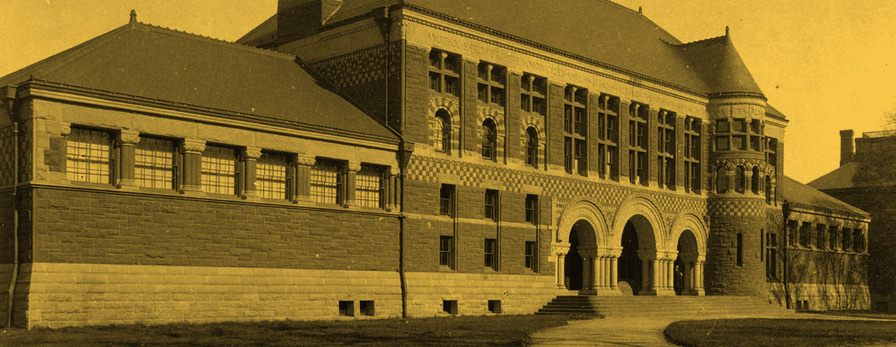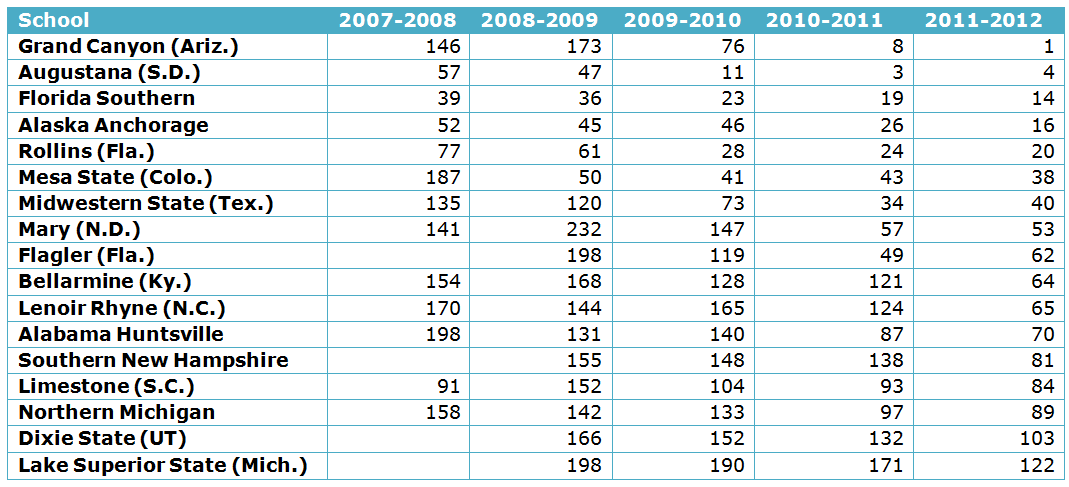Not since 2000 had a reigning Directors’ Cup holder failed to defend its title as the best athletic program in NCAA Division II. 1 In fact, not since 2004 had a runner-up even finished within 150 points of the Cup winner.
That year, Grand Valley State took up the vacancy, left in the wake of UC Davis’ move to Division I, and never relaxed its stranglehold on the trophy. Runners up in the previous two final standings, the Lakers followed up their first Directors’ Cup with seven more, and coming off a season in which its next challenger lay a distant 277.75 behind, a ninth straight Cup in 2011-2012 looked like a foregone conclusion.
Grand Valley State’s recent second-place finish certainly came as a surprise. But the bigger surprise might be the usurper who perpetrated the coup. The same year GVSU began its glorious run, Grand Canyon University underwent a transformation into a publicly traded for-profit entity due to financial concerns.
The move shored up Grand Canyon’s fiscal situation and laid the capital foundation for the university’s burgeoning physical foundation. Department-wide facility developments, such as the GCU Events Center opened in the fall of 2011, have coincided with a breadth of on-field accomplishments.
All of Grand Canyon’s fourteen NCAA sports contributed points to its improbable Directors’ Cup title, the culmination of a complete program about-face. GCU upped its overall point total by increases of 171.50, 380.00, and 302.00 over the last three academic calendars to elevate its final ranking from 173rd in 2008-2009 to the very top in ’11-’12. The Lopers are currently waging their only title defense before joining the Division I WAC in fall 2013.
To be sure, Grand Canyon University’s metamorphosis makes its model somewhat of an outlier, but the core of its athletics development isn’t so unlike that at a number of other athletic departments, where major facilities upgrades and an expansion of sport availability have dovetailed nicely with consistent and considerable success in recent Directors’ Cup rankings.
Since 2006, Augustana (S.D.) has raised over $15 million from donors to support the building and renovation of on-campus facilities. Projects made possible in part by these fundraising efforts include an ambitious 2009 construction campaign: a brand new football stadium, soccer field, and tennis center.
In the years following those projects’ completions, Augustana’s final ranking has skyrocketed to 11th, 3rd, and 4th from 47th in the 2008-2009 season. The Vikings sent at least two teams to postseason play in each of the fall, winter, and spring seasons this past academic year.
Meanwhile, a whopping 12 Florida Southern programs qualified for their postseasons in 2011-2012. That department-wide success propelled the Moccasins to 14th overall and their fourth consecutive higher final placing. Also laying claim to such a feat is SSC rival Rollins, who followed up a 77th ranking in 2007-2008 with a 61st, 28th, 24th, and a 20th place finish this past season. To boot, both schools have introduced men’s and women’s lacrosse programs to their arsenals in the last five years.
Bellarmine (KY) has also fostered prolific success within its athletic department. Since 2007, Bellarmine has constructed a multipurpose home for its soccer, field hockey, lacrosse, and track & field teams; played host to 12 D-II National Championships in a three-year span, claimed the D-II national title in men’s basketball, the school’s first overall; and raised its final Directors’ Cup standing by 90 points.
Below is a more complete lists of schools that have consistently and significantly climbed the D-II Directors’ Cup standings since 2007-2008.
Key Insights
We looked at DII programs making strides in the Directors’ Cup and found that Grand Canyon University and Augustana University made significant gains since 2007 – 08. Florida Southern and Bellarmine also finished strong. Many programs have seen success after facility upgrades and expansions of sport availability.
References:
- For great research into the variables that predict success in the National Association of Collegiate Directors of Athletics (NACDA) Directors’ Cup. See http://csri-jiia.org/documents/puclications/research_articles/2012/JIIA_2012_5_11_207_224_NACDA.pdf ↩





